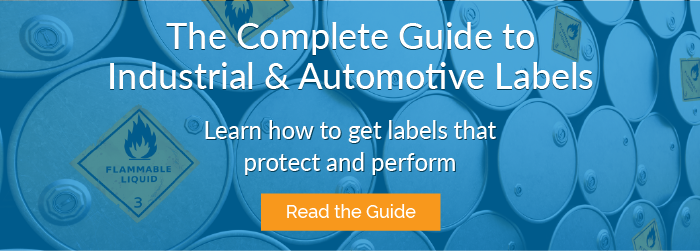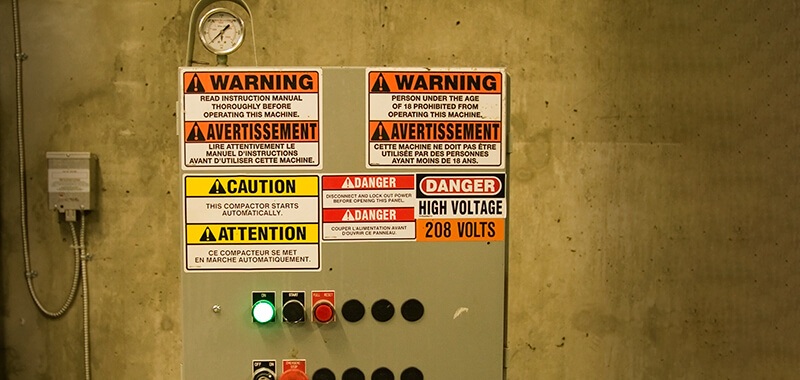
An industrial environment is replete with hazards: Heavy machinery can exert crushing forces, high-voltage electricity can incapacitate, extreme heat can inflict third-degree burns, and caustic chemicals can blind and eat through skin.
People who work in industrial settings wear hardhats, safety glasses, gloves, steel-toed boots, and other personal protective equipment to protect themselves. But among all that, industrial labels may be the most essential pieces of PPE.
The symbols, words, and images on industrial labels aren’t just there to attract attention – although to do their jobs right, they must be eye-catching. These vital elements of iconography exist to prevent injuries and preserve lives.
Industrial labels protect other things, as well – namely, the reputations and revenue of industrial organizations.
To ensure the safety of workers and prevent environmental disasters, federal and state governments regulate industrial workplaces heavily. Many of these regulations have to do with labeling. Therefore, industrial labels not only prevent accidents, but lawsuits, fines, and bad press.
We know industrial labels are important, but what’s important when making an industrial label?
Industrial labels must be durable and strongly resistant to heat, light, moisture, corrosive solvents, and other environmental factors that can cause labels to fade, crack, rip, or peel.
In addition to being durable, industrial labels must communicate in a consistent, regulated way. Why? So that the message is consistent, making it easy for safety information to be clearly – and quickly – understood. Here are some of the symbols, phrases, and colors found most often on industrial labels:
ANSI Safety Colors
The American National Standards Institute (ANSI) oversees the ANSI Z535 set of standards, which pertain to the design, use, and application of safety labels and signs. While ANSI compliance is voluntary, many regulatory bodies, such as the Occupational Safety and Health Administration (OSHA), reference ANSI when creating their decidedly non-voluntary rules.
(The international equivalents of the ANSI Z535 set of standards are ISO 3864, which covers safety signs, colors, and warnings; and ISO 7010, which covers shapes and symbols.)
ANSI Z535.1 sets the standard for each safety color: red, orange, yellow, green, blue, purple, white, brown, gray, and black. The document explains what each color symbolizes and defines each color in technical terms for printers and label manufacturers.
This definition describes each color’s ink formation, names the closest Pantone color, and sets acceptable tolerances illustrating acceptable ranges in hue, value (lightness), and chroma (saturation).
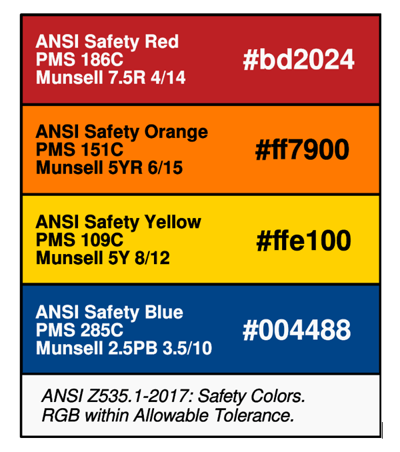
ANSI Safety Symbols
ANSI Z535.3 outlines the proper safety symbols to choose when designing safety signs and labels, as well as how to color and format each symbol.
The overall goal is uniformity. It’s important for all safety symbols that warn against similar hazards to look the same. This way, workers can identify risks immediately, without puzzling over the interpretation of icons.
For example, ANSI-compliant warnings against the risk of electrical shock (such as the one below) are instantly recognizable.
Likewise, the ANSI symbol for “biohazard” would make anyone proceed with caution.
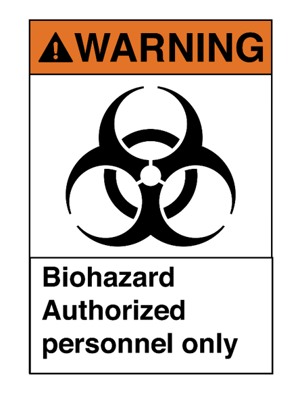
ANSI Signal Words and Safety Headers
Along with colors and images, the third way industrial safety labels alert people to the presence of hazards is through words.
ANSI has specific definitions for words like “danger,” “warning,” and “caution” that relate to how likely the hazardous situation is to cause death or severe injury. The definitions are contained in ANSI Z535.2, which also prescribes “a consistent visual layout” for environmental and facility safety signs.
Each ANSI signal word is associated with a color (as described above) and a symbol. For example, the term “danger” should be encased in a red field and accompanied by a white or yellow triangle containing an exclamation point.

“Warning” should be written in black and placed against an orange background.

GHS Pictograms
The United Nations created the Globally Harmonized System of Classification and Labelling of Chemicals (GHS) to establish universal global standards for warning pictograms and safety data sheets for potentially dangerous chemicals. In 2012, OSHA integrated the GHS standards into federal regulatory law.
According to the GHS, all chemicals used in workplaces should be labeled with:
- A GHS hazard pictogram. A GHS pictogram communicates information about physical, environmental, and health hazards at a glance.
- A signal word (similar to the ANSI signal words) indicating the severity level of the hazard. Signal words include “danger” and “warning.”
- A GHS hazard statement. Hazard statements are short, standardized phrases or words that designate hazardous chemicals as members of various hazard classes, such as “explosive,” “flammable,” “corrosive,” or “fatal or toxic if swallowed.”
The chart below shows some examples of GHS pictograms and hazard classes:

Get Expert Assistance with Your Industrial Labels
The standards and regulations surrounding industrial labels can be complex. For example, what’s the difference between an environment that calls for “caution” and one where the word “warning” is more appropriate?
If you’re not sure how to design and format your industrial labels – or just need a second opinion – it helps to work with a label printer that understands the intricacies of industrial labels and has an appreciation for the critical, life-saving roles they perform.
Contact the industrial label experts at the Label Printers today, or view our portfolio of industrial and automotive labels here.

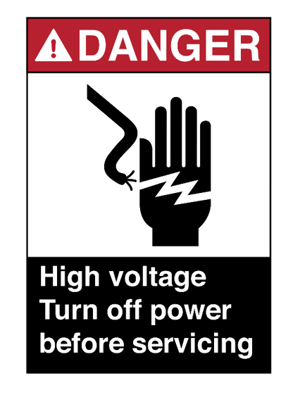 (
(